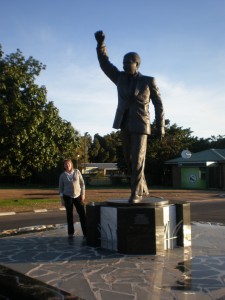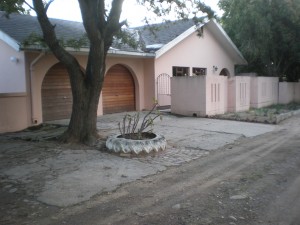
I said there’d more about South Africa. So here is a little story to mark the 20th anniversary of Nelson Mandela’s release.
One afternoon in August as the South African winter began to think about spring, G and I were driving along a road, on our way back from a winery near Franschhoek when we realized that we were very near to the Drakenstein prison. The Drakenstein used to be called Victor Verster and we realized it was the last prison where Nelson Mandela was held before he walked along that long avenue, surrounded by exultant, grinning people, into the glare of the press and into the responsibility that lay in his hands.
So, we had to go see.
We knew we were in the right place because outside there is a statue and, of course, we had to take our photos there. But my husband wanted to see more and despite my grave reservations went to talk to the guards at the main gate. After about ten minutes he came back, got into the car and instead of driving back onto the main road, turned up the long road into the prison. He’d been told to ask at the main office.
We passed by fields and playing fields and then stopped outside the low single storey admin building. G hopped out with a cheery “if I’m not back in eight years come and get me” and disappeared inside. Minutes ticked by as the cliché has it. Quite a few minutes actually until I was beginning to wonder if I was in for a longer stay than planned. Then out came G and a warder and a young man who got into a car and waved to us. And off we went, following them along the road past wired compounds with exercise yards and accommodation blocks and then bouncing along an unmade country road until we drew up beside a couple of bungalows. We parked under a tree and there was a pink building. That’s it our warder told us. Mandela’s house. And the house next door is where his body guards lived.
It looked unlived in. The curtains were half drawn and there were weeds growing in the yard. We walked round with our black warden and the white young man who, it turns out was an electrician come to do repairs. We peered into the windows into empty rooms and saw the kitchen where Mandela must have made tea or prepared a meal. To the back of the house the young man opened a gate in the back wall revealing a vast, tangled landscape rolling out to mountains. “Look at this” he said. Isn’t it wonderful?” Then he just stood and looked for a minute before closing and relocking the door.
We went into the back garden where there was a small, half-empty, swimming pool beside the shaded terrace. We all stood by the pool and I was deeply moved. “There”, said the warden, indicating the shaded garden, “that’s where the Old Man used to sit. That was the Old Man’s room”
The four of us fell into talking. Our warden was from Kwa Zulu Natal but had been promoted to the Cape. Which did he prefer? Kwa Zulu – it’s so green and his white colleague agreed that the summers in the Cape are fierce and unforgiving with temperatures heading north of 35 even 40 degrees at time. And they talked a bit about community relations – the tensions between coloured and black – and I realized from a comment from the warder that the young man was, in fact, coloured. They understood and were talking in a context that I could have had no idea of. But of course, race is part of every discourse in South Africa. They talked about the education projects in the prison and how they hope to provide their predominantly young offenders with a skill and some sort of a future in agriculture. About the eggs that the prison supplies to traders throughout the area.
I have a lot to learn about but I do know this. That standing with a couple of South Africans who recognized the different places each came from, who both loved the land they live in and work alongside one another; who both spoke of the cautious moves toward each other, in a garden where the Old Man, Mandela sat and worked on the future in his hands, was one of the most memorable events of my life
Leave a Reply
You must be logged in to post a comment.